#wallachian history
Text

A question that doesn't come up often enough: Where's the rest of Trevor's family?
We know the entire Belmont line was almost completely annihilated in a mob, but the series is pretty vague on how many people were actually living in the house. With a high mortality of the medieval period, families were often big and with an occupation as dangerous as hunting monsters, the Belmonts were probably no different. This was very much a 'survival of the fittest' and 'heir and plenty of spares' mentality.
Trevor lost his family at twelve, so it's very unlikely he was the only sibling. But even in the event his parents were extremely unfortunate and he was their only surviving child, the multiple siblings theory still applies to the previous generations.
So his immediate family was killed. What about the extended family?

In Lament of Innocence, Leon Belmont was a French baron, but he gave up his land and titles to rescue Sara. Following the storyline of the Netflix series, he then chased Dracula east and neither the games nor series ever mention what became of him other than the fact he fathered the entire bloodline.
Based on the games, it would be safe to assume the Belmonts are not part of the aristocracy, but as far as the series goes, they are mentioned as one of Wallachia's 'great houses' in the first couple episodes. They're not unknown to the Wallachian people. Plus, the reigning Prince of Wallachia did have the power to invest anyone he chose with a noble title. The real Vlad the Impaler actually made use of this power by elevating members of the lower classes, effectively ensuring their loyalty through gratitude. (Because if he was overthrown, things weren't going to go well for the people who benefited from his rise to power.)
So it's not impossible that somewhere in the 400 years between Leon and Trevor, some Belmont won the favor of Wallachia's monarch and was rewarded with a boyar lord's title.
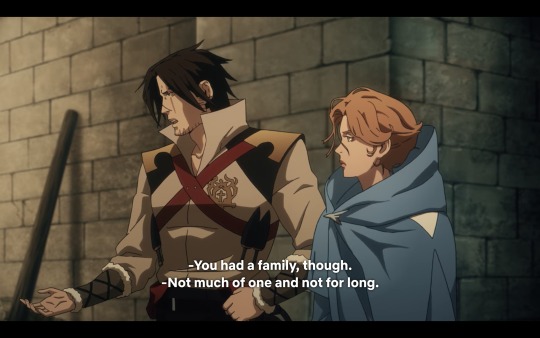
'Not much of a family and not for long' seems to indicate the line was already pretty diminished before the mob attacked.
Trevor only mentions his family a handful of times throughout the four seasons, and the only specific members that come up are his parents with the reference to his mother's books and the story of how his father had once gotten into a fight with a Speaker.
The only other time his parents come up is in Season 2 when Sypha asks if they were magicians, to which he answers no, but they knew a lot about magic. At the very least, this shows both of his parents were alive long enough for him to remember them. Otherwise, the story about the fight with the Speaker could have easily been told to him by another relative that had been looking after him while the books Trevor mentions that belonged to his mother could have just been part of the family's collection after she was long gone.
With some historical context (provided we adhere to accuracy,) this actually gives some insight to Trevor's childhood. He would have known his mother very well. Unlike many other European countries where the nobility left childrearing to a nurse and other staff, the education of a boyar's son in Wallachia was actually left to the women of the household. His mother would have likely overseen every part of his upbringing that wasn't physical combat training, which would have been his father's domain.
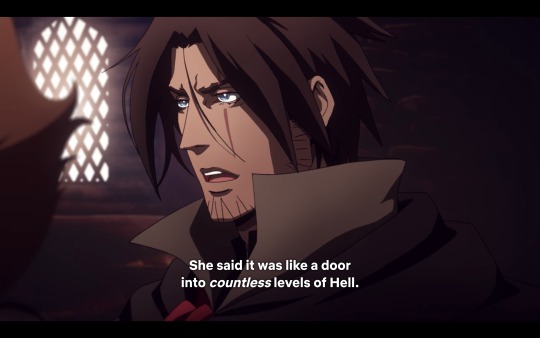
Another possibility worth exploring is his mother was the Belmont and his father was the one who married into the family. An unusual if not unheard of dynamic for the times, but the series does subtly imply the women of the family were as much of hunters as the men when Trevor talks about how only one member of his family encountered the Infinite Corridor. It's possible they could have adopted other more non-traditional roles for the times.
This also accounts for his complete lack of surprise in Episode 3 when 'the Elder's grandchild' turns out to be a granddaughter and again in Episode 4 when Sypha reveals herself as a mage.
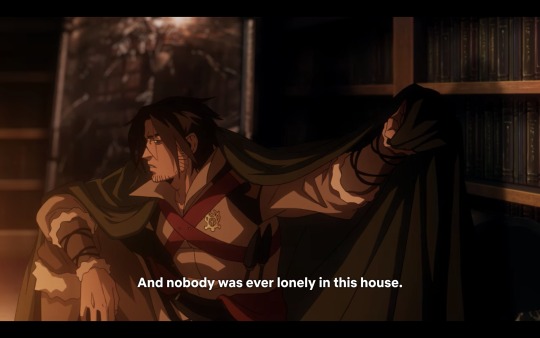
So we've established both of Trevor's parents were alive and well for a significant part of his early life. On to the extended family.
Unless the Belmonts were practicing Targaryen levels of incest (although marrying one's cousin was an accepted practice in this time,) Trevor should have had other relatives to rely on. Assuming the family had a traditional dynamic and his mother did indeed marry into the Belmont line, and since aristocrats generally married other aristocrats, her father would have been one of the boyar lords of the region. The same applies if his father had sisters who married into other families.
Given the primary goal of marriage in this time period was less romantic and more in the interest of forming alliances with other families for political or financial reasons, there could also be a wider family network among the nobility at play.

Side note: There's a small possibility he's distantly related to one or both of these two.
...
So what happened to those other relatives?
Personally, I think the answer to this question might play into the cynicism and bitterness of Trevor's character in general. If we explore the scenario that he did seek help from his mother's family, people who had no ties to the Belmonts other than the fact their sister/daughter married into the family, with the self-serving atmosphere of the Wallachian aristocracy at the time, I can imagine him being met with a cold reception.
And sadly, this would be an all too realistic situation for the times. As stated above, the boyars were corrupt. There wasn’t a clear hierarchy among the nobility (That is, Wallachia did not have the equivalent of dukes, earls, viscounts, etc.) so power was determined by wealth or land-owning. This rivalry for power went all the way to the top; Wallachia's throne changed hands once every couple years as the Dănești and Drăculești branches of the reigning family relentlessly fought over it.
In this minefield of political intrigue, the only surviving member of an otherwise shattered bloodline, especially a twelve year old excommunicate, would not have been of much use in the eyes of the nobility. With the Belmonts disgraced with heresy charges, neither branches of the reigning family would have been interested in their support and probably would have wanted to distance themselves from an alliance that could potentially damage their own reputation.
A public rejection from the Prince would have rebounded throughout the region and put the final nail in the coffin of what the Church started. None of the boyars would have been interested in helping Trevor, distant family or not. On the other hand, helping their orphaned and disgraced nephew/grandson is the Christian thing to do, but since Trevor and his murdered family are now enemies of the Church and out of favor with Wallachia's monarch, that 'help' might've extended only as far as, "We're deeply sorry for your circumstances. Here's some money, now get out."
So Trevor was born into one of the highest and most privileged classes in the region and is the product of literally generations of a family that has had two goals since Leon: protecting the world from Dracula and the destruction of Dracula. The night of the mob would have completely shattered a mentality he'd had since he was born. Throw that on top of that the trauma of losing one’s home and entire immediate family in a single night and then being vilified by both the people his family had protected and the wider circle of his extended family.
That is a brutal shift in world views for a twelve year old to handle, so it's easy to see why the series opens with him already burned up the anger and the grief over what happened and all that’s left for him is the aimless wandering, drinking, and getting into fights.

In all, this statement really summed up the beginning of his character arc perfectly.
#castlevania#trevor belmont#belmont family#sypha belnades#character analysis#castlevania headcanons#castlevania targoviste#character development#speakers#medieval wallachia#wallachian social classes#medieval romania#medieval history#medieval europe#wallachian politics#game of thrones reference
131 notes
·
View notes
Text
/ What are the chances that a bat god would fall in love with (insert ur muses' name)-
#WHAT are the chances that the last emperor of the Byzantine empire would fall for (insert ur muses' name)#what are the chances that the god of the night sky; hurricanes; conflict; obsidian; sacrifice woums fall in love with (insert ur muse name)#what are the chances that one of the best warriors during the kurukshetra war would fall in love wit-#what are the chances that the king of ithaca who fought on the trojan war + embarked on a journey that seemed to have no end would#fall in love with (insert ur muses' name)#what are the chances that a bat god and (ur muses' title) would fall in love-#what are the chances that a man considered to be one of the most important rullers in wallachian history would fall in love with u rn-#I COULD GO LIKE THIS ENDLESSLY#im missing more but#basically; i wanna write pinning and romance and and-#im putting all of them on the table 😳
21 notes
·
View notes
Text
Costuming Strahd: Part 1
An "I thought too hard about this" adventure.
I recently picked up some fabric for Strahd (because you know I gotta dress up when my players eventually come to dinner).

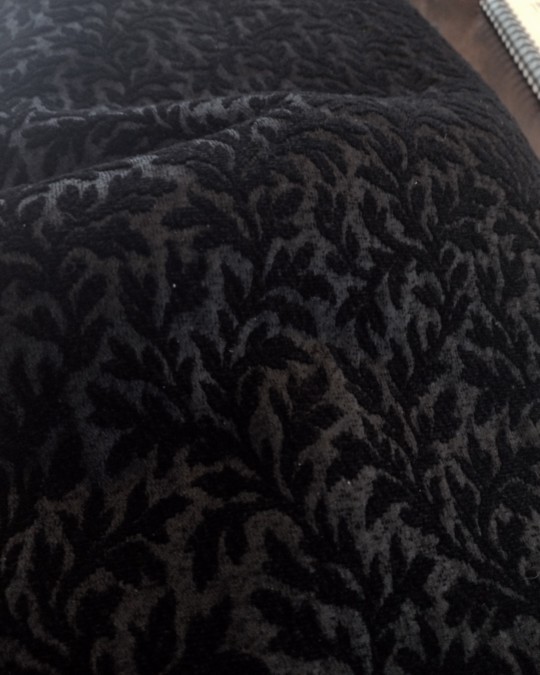
A "fine black linen" for the shirt (from here if you want to grab some for yourself), and a black jacquard chenille (kind of a mid-weight upholstery fabric) for a classy vest.
I started doing some visual research on traditional clothing in Slavic and Southeastern European regions, hungrily compiling whatever I could find to build some pattern recognition.
Having a little bit of trouble reconciling traditional peasant garb with "but what would nobility wear" and "what year is it", plus the obvious influence of Dracula and his early cinematic adaptations on descriptions of Strahd von Zarovich (which are decidedly Western), and the need to remind myself that I am building a fantasy costume not some historical reenactment.


1937 print of a Wallachian peasant vs. a portrait of Vlad Țepeș noted 1466
The vague description from I, Strahd: The War Against Azalin gives me a neat little list of his layers: "cloak, outer coat, embroidered vest, and . . . a very fine black linen shirt."
The "outer coat" threw me. I suppose it shouldn't have. But it didn't quite mesh with the Ottoman influences in Vlad Țepeș portraits nor the stout vest and almost oversized coat ensembles I'd been looking at in peasant images from Romania and Hungary. Instead, that kind of layering really read Western Europe to me, so I was shunted directly back to Christopher Lee's portrayal of Dracula (in which his costume really is black-on-black-on-black, apart from the barest hint of a white shirt beneath the squarely Victorian suit, which easily consists of both a vest and jacket and, in this case, a cape).
Side note: Nowhere have I (yet) found mention of any sort of necktie. Just the Bela Lugosi style crest (but on a gold chain, not a ribbon).
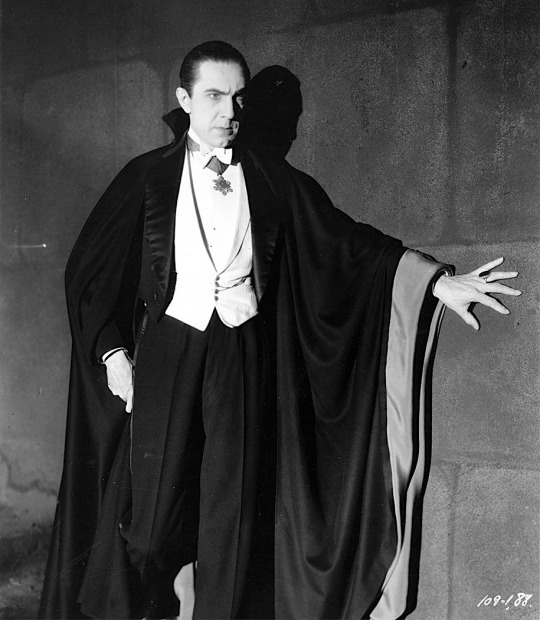

There's just something about that 1930s white tie, folks. Mm.
Anyway, I figured it was safe enough to start with Strahd's shirt. Well... but, herein lies still the same conundrums: shirts aren't all the same spanning eras and regions. I did stumble on this, though:
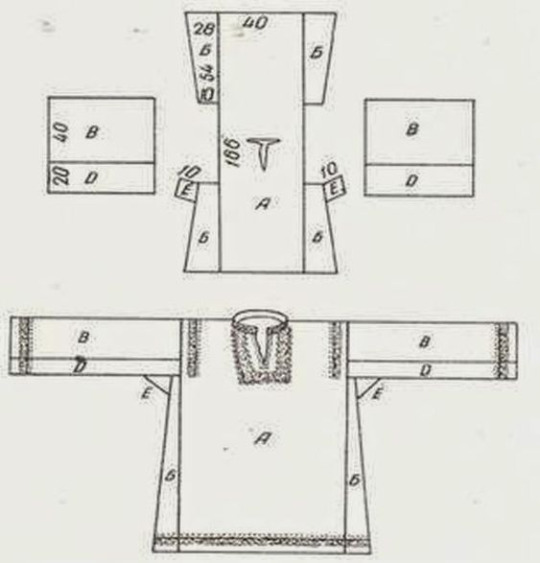
I love me a pattern.
What I like about this in particular is that it's structured in a way that makes me believe Strahd was inspired by a man who lived in the 1400s. These sort of blocky, pieced shapes were how shirts were commonly built throughout much of history, with various amounts of gathering and whatnot, so it could be pretty versatile in terms of "what year is it".
I like the embroidery on the neck, cuffs, and over the shoulders. And I like that the split in the neckline is centered. I've seen examples with the split at the side of the embroidery panel that are really intriguing, but while a few have been noted as Ukrainian or Polish, most of the examples I've seen have been Russian, and I'm trying to avoid anything overtly Russian. (Russian garb is yummy, but it's not Barovian.)



The lighting on that third one is either ominous, suggestive, or both.
What I don't like is the open sleeve ends. There are certainly worse offenders (there are some HUGE open sleeves in some of the folk ensembles, like, unconscionably long and billowy), but even this kind of straight sleeve doesn't feel... I don't know... organized enough for Strahd.
I have a Viking style shirt with straight open sleeves like this, and it bothers me to no end. The material over the thin part of my forearms and wrists is floppy. It crumples and rides up (maybe they're just too big overall, but that's a risk to consider). I usually just roll them up to my elbows to have done with it, but that's a move for casual wear. I could see Alek Gwylim sporting open sleeves, but not Strahd. Strahd needs cuffs. Or if not cuffs, the kind of sleeve that narrows tight around the forearm and probably has at least a dozen buttons running up the length of it... but that's hardly practical, either, is it? Strahd treads that infuriating middle ground somewhere between comfortable and elaborate.
So anyway, I'm probably going to enlarge the sleeves. Not a lot; just enough to get a little bit of that "poet shirt" gathering on the shoulder and allow some extra movement in the elbow. And it's going to have cuffs that button around the wrist. Turning it into something a little more suggestive of the Renaissance (though I'm sure as hell not adding ruffles; I'm sure Strahd would think them frivolous).
Side note: Cuffed sleeves are not unheard of in folk garb from Romania and surrounding areas, but it still felt like a very deliberate choice to make. There's certainly a noticeable trend of open-sleeve styles, especially in Transylvania, if I understand correctly.
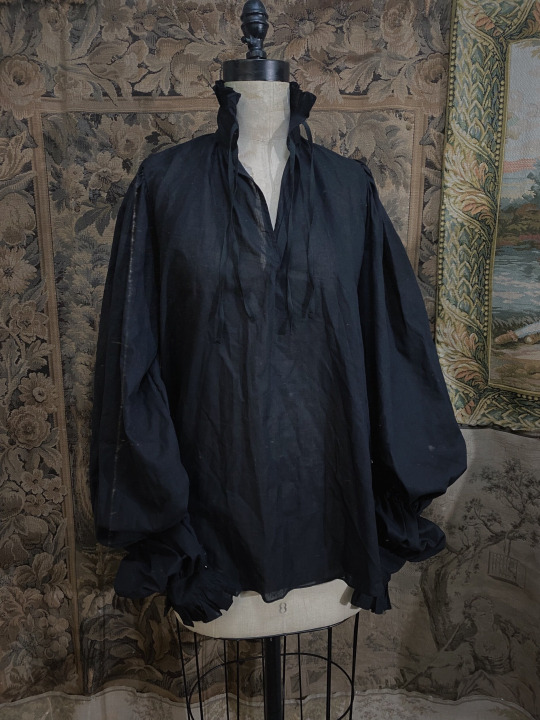

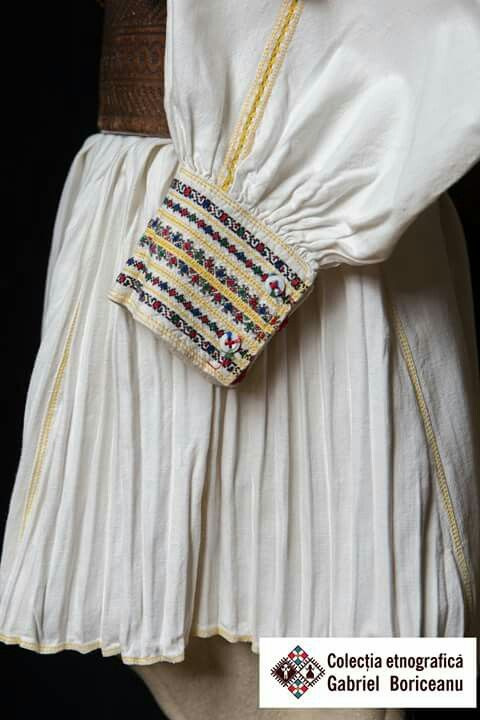
That first image is from I Do Declare. Great stuff.
Ultimately, the slightly tucked, cuffed sleeve should also bleed well enough into late-1800s suit territory, at least in spirit. The sleeves should have the approximate volume as (or perhaps a little more than) a modern button-down shirt.
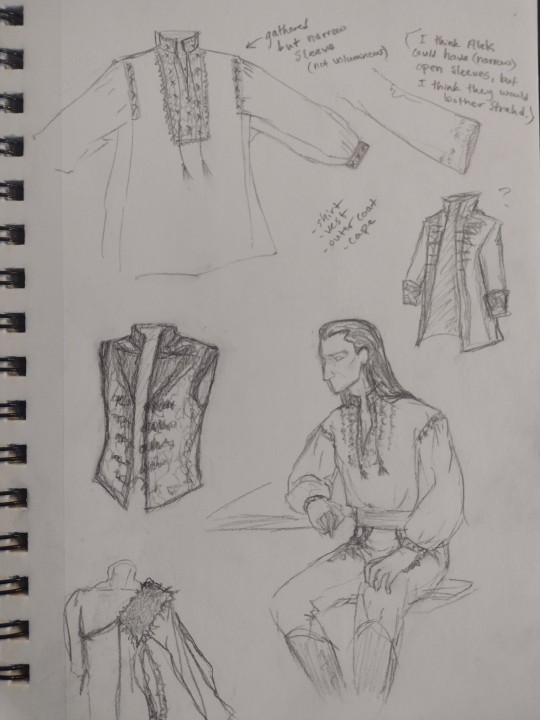
Little concept sketches.
Building up from the body, the vest is the next most important thing (aside from pants, but I'm just looking at his torso for the moment; you can fake good pants, especially at the table).
Whatever happens, I knew the vest should be at least these two things: black, and embroidered. Why not blackwork on black fabric? And, since I've picked out a jacquard fabric that already has some texture to it, let's just keep piling on that subtle intrigue. That's right: get up close and personal, look at that mesmerizing detail... lol.
I do not have an actual plan for any of the embroidery yet. That's a problem for future me. (Good luck, sucker.) What I would like to do, vaguely, is take some of the traditional/folk embroidery from that southeastern region and combine it with more western Victorian elements. Haphazardly span worlds to mimick the elvolving lore.
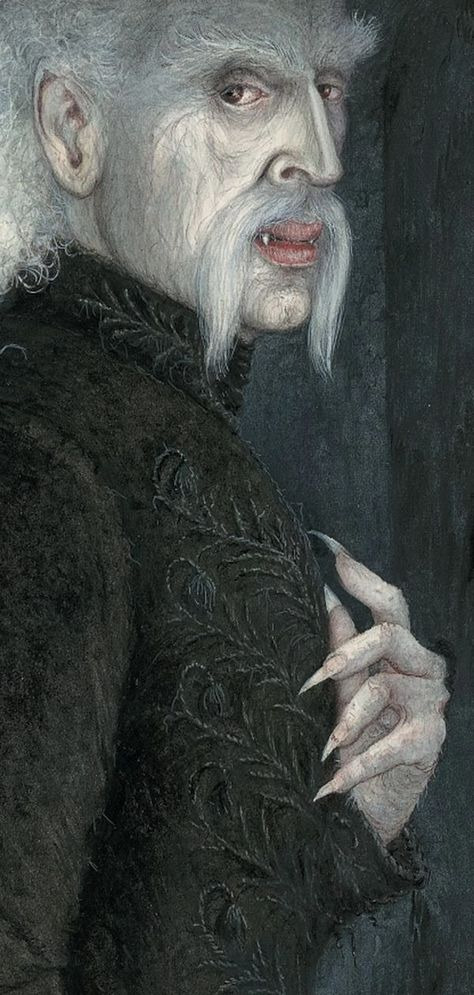

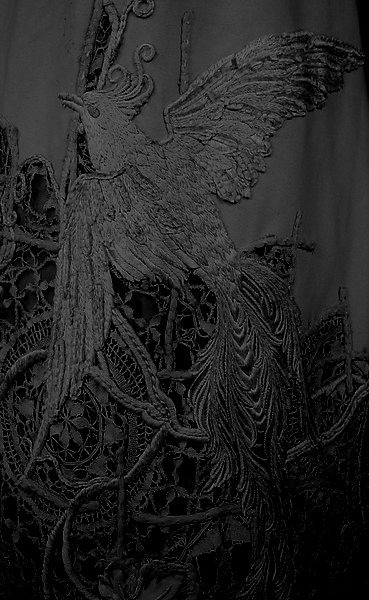
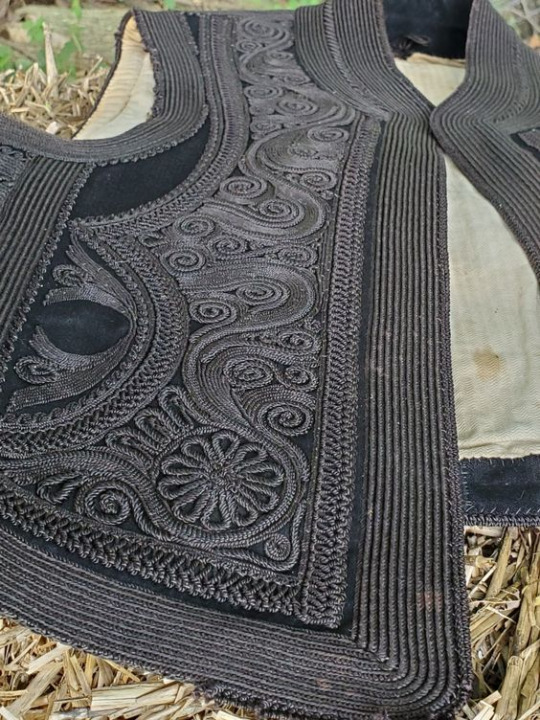

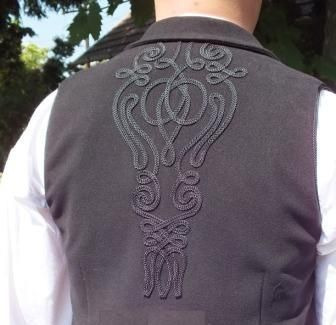
Soutache, anyone?
The style of the vest I sketched out is based on the below examples of traditional Romanian outfits (from what region, I have no idea). The nubby little lapels reminded me of late Victorian waistcoats (which button up rather higher on the breast than modern suits), but with the added fun of a standing collar. That thick black embellishment also caught my eye, of course.
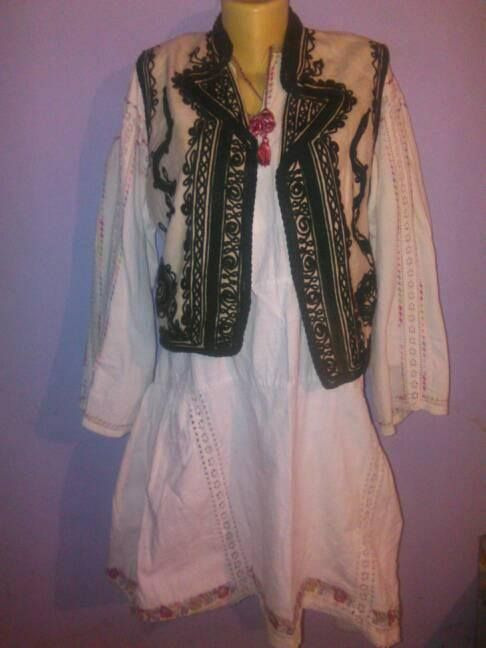
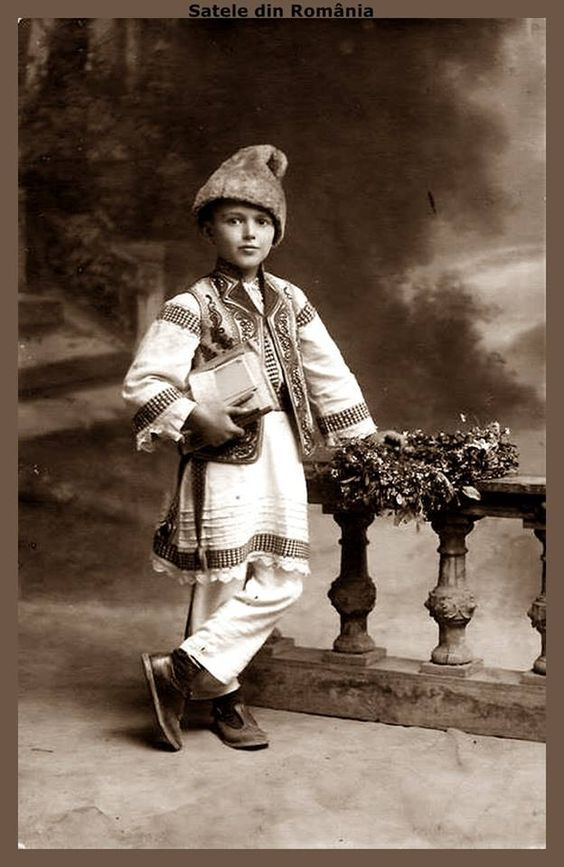
Look at that dapper little guy.
I would like the vest to be more fitted, though, rather than the boxy, open-front (and often sheepskin or fur-lined) style of traditional peasant dress.
Along a similar vein as "the man needs cuffed sleeves", having a more tailored vest seems practical and organized. Crisp might be the word I was looking for. And he's a lord, he can afford the extra effort. A fitted waistcoat would also play along with the little fantasy Renaissance lean and nods to Victorian fashion.


Strahd said trunk hose were a thing of the past, but made no mention of doublets one way or the other.
That's it for now. I was definitely just going to do a quick intro this morning, but here it is, evening again. Joy of joys. This is my work.
. . .
[Next - Costuming Strahd: Art Addendum]
#lamour dms cos#costuming barovia#strahd von zarovich#inspired by dracula#curse of strahd#strahd cosplay#barovia#ravenloft#fashion history#folk costume#costume things#dear god am i actually blogging
44 notes
·
View notes
Note
Hey now how could you say such nasty things about the show? Don't you realise how important it is for lgbt representation? I bet you're some bigoted neckbeard!
Go back to your jumping pixels on the ps2 and leave us alone you gatekeeper!>:(
I know you joke and all, but it's honestly baffling to me how NFCV (and esp Nocturne) got the reputation of being woke because of one (1) bi threesome, when it's shockingly bigoted itself.
Wallachians are depicted as backward hillibillies brainwashed by the Church and engaging in bestiality: classism and xenophobia due to them being Eastern European, plus a general shallow caricature of history.
Alucard mocks the Belmonts by accusing them of being "mentally ill hoarders" and engaging in pagan rituals such as sacrificing chickens and mummifying cats: ableism and xenophobia, not helped by the fact that he's technically a nobleman looking down on common people (so classism).
Trevor is an alcoholic because of genuine childhood trauma. He's constantly mocked by other characters (and even the fucking music sometimes), he's pushed aside in favor of Alucard who is the first person who disrespects him, and eventually ditched by his own story.
Carmilla, the quintessential lesbian vampire in popular culture, jokes about being willing to fuck Godbrand only if all the men, half of the women and some of the animals dropped dead: equates having sex with women with having sex with animals.
Isaac's backstory is being a slave owned by a Catholic priest, so historically inaccurate that it can only come from the preconception that black people can only exist in Europe as slaves.
Isaac is a self-professed Muslim man who gleefully worships a demonic creature and agrees with his idea of killing "impure" people for a superior mission, justifying his sins by misquoting the Quran. His hypocrisy is never pointed out, and we're meant to admire him all the way through. I cannot make this shit up.
The generals in Dracula's court come from all over the world, with prominent Indian and Chinese vampires, but they are literally props only there to pretend the world is bigger than it actually is: the focus is given to two white Northern European vampires, Godbrand and especially Carmilla.
Striga and Morana are the laziest form of lesbian representation you could possibly have, literally Disney level of "seventh first gay character".
Alucard got "revealed" as bi in a tweet as if to reassure us that no, he wasn't raped, he enjoyed it! Pure biphobia.
Hector's whole story in S3 and 4 is disgusting rape apologism stemming from sexism, both against men (men are inherently horny and they cannot get sexually traumatized) and against women (women are never a threat and everything they do is inherently titillating).
Vampires, unholy creatures who can only exist by causing harm to humans, are treated as if they were their own separate race, and as if the Belmonts are committing ethnic cleansing against them. Case in point, Alucard being such a cunt to Trevor because oh no, his ancestors killed vampire children and kept their skulls in their hold! As if "vampire children" would be anything else than a cursed existence. (and never forget about the "cabal of vampires" controlling the slave trade in Nocturne, or how in that show vampires are the literal ruling class to be crushed by the revolution.)
oh but game isaac is offensive because he looks like a bdsm stripper or stuff. sure whatever.
At least Nocturne had the decency of fleshing out its gay couple. Yay, progress.
#anti netflixvania#i honestly wonder if the people who profess their love for the show have ever rewatched it#it's impossible to rewatch it and not notice how fucked everything is
38 notes
·
View notes
Text
The Horned Serpent
So before I get started on this one, I have a couple of things to get out of the way. First, I will be using she/her pronouns for the Horned Serpent; this is just because UPG and because I'm used to it. I know someone else who venerates/worships the Horned Serpent, uses they/them pronouns for them, and considers them to be beyond gender / present as whatever gender they feel like. Second, I will be focusing on my interpretation of her on the Gundestrup Cauldron, in part because there's really not a lot of literature on her, even when you include works that specifically analyze Cernunnos' depictions. Third (and related), I will be using the National Museum of Denmark's estimate as to when/where the Gundestrup Cauldron was made, which is roughly in the Danubian or Wallachian Plain(s) around 150 BCE to 1 CE (link).
So first a little historical & cultural context. This area, as far as culture groups, would have been a heck of a melting pot, between the Dacians and Thracians that already lived there, the Scythians coming in and also living near by, the Gauls that moved in around the 300s-200s, the Greeks who came up and started establishing colonies along the Black Sea in the 300s, and the Romans, encroaching on everyone's business around the time the Cauldron was built. A pretty solid primer on the history of the region is A Companion to Ancient Thrace, published by Wiley Blackwell.
So I'm gonna try to make sense but it might be a little disorganized going forward. Anyway, onto the actual thoughts & stuff. So anyone who's taken even a passing glance at Cernunnos is well aware of the Horned Serpent, since she is present in basically every ancient art you can find with him. On the Gundestrup Cauldron, she appears three times, all on the interior panels. One is at the Hero's heel, who's holding the wheel; a second is at the end of a line of heroic riders, which seems to be a Thracian horseman motif; and of course the famous Cernunnos panel. In Thracian Tales of the Gundestrup Cauldron, published by Najade Press, Jan Best presents an interpretation of the interior panels as a story, and assumes that Cernunnos is singing in his famous panel, specifically about the secrets of immortality, a concept which was very popular at the time. I agree with this and I also assume that the depiction of Taranis / the wheel god is that he is also singing, and if he is singing then the lions and griffins - both predators associated with kingship (griffins were protectors of the pharaoh, and also decorated certain tombs out in ancient Persia), then the action of passing off the Wheel must have symbolic meaning, such as being handed the Wheel of Heaven.
The Gundestrup Cauldron's exterior also has very clear influence from the Scythians, you can almost 1:1 map the gods based on Herodotus's retelling of the Pontic stories. I believe there are also thematic parallels going on here on the Wheel God panel, featuring a new god/king being given the symbol of his domain. Wikipedia actually has some relatively thorough articles on Scythian religion as well as the genealogical myth specifically, which is the myth that I personally associate with the wheel-giving panel. As well, the animals in this panel don't appear to be particularly concerned with attacking anyone - if anything, the griffins and lionesses are slightly tilted from one to the next, which makes me think it's more likely that they are dancing, especially if the human/divine subjects are singing, especially if the human with the helmet is receiving a high honor, potentially his rank amongst the gods. In this panel, she is just at the hero's feet, not really joining the parade if the animals, but clearly not ready to attack either, but her attention does seem to be drawn towards the hero.
The final panel she is on is the panel featuring the nine soldiers and the heroized dead, represented by the "Thracian horseman" motif. After Alexander the Great and his penchant for having statues of himself be on horseback, it became popular for wealthy men and nobles to depict themselves riding horseback to a goddess or sacred tree (unfortunately my best source discussing this in English is also not great and he comes up with some..... questionable theories), but the popularity seems to have blown up to the point where even deities such as Zeus were depicted on horseback in a similar manner. There are also mentions in a few other sources that the Thracians believed in the ability for people to essentially become immortal after death. Unfortunately, I'm having trouble sorting out my notes and this essay has been nagging me for weeks now.
Anyway, I interpret this panel as what is expected to happen to us after we die - the "ordinary", so to speak, are lead to a deity, likely to be reincarnated (this is honestly just a guess on my part largely due to the popularity of that in Greece for ever, and Grecian influence was in full swing by the time the Cauldron was made), meanwhile the "extraordinary" are lead by the Horned Serpent.
This is where I tie all three together to my upg/theology: The Horned Serpent is a friend and ally to Cernunnos. He teaches the secrets of life after death to those who will listen. The Horned Serpent is by his side during his teaching, and when we die, if we have proven ourselves worthy during life, she guides us through the trials of the afterlife. If we succeed in these trials, we are awarded with apotheosis - becoming a god or godlike - and she stands by our side as we earn this prize.


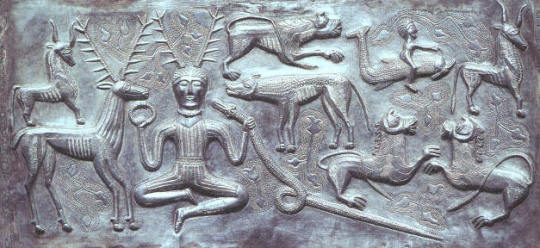
@musingmelsuinesmelancholy sorry it took me so long x.x & I hope this makes sense!
#cernunnos#thracian polytheism#gaulish polytheism#dacian polytheism#scythian polytheism#the horned serpent#balkan paganism#celtic paganism#paganism
19 notes
·
View notes
Note
What subgroup are the Maximoff’s most likely to come from? We know that Magda’s Sinti but to my knowledge nothing has been confirmed about them (I personally think that they’re Kalderash but I was wondering what you thought about it)
Kalderash is a good guess. It makes sense, based on the region they're from. Matéo Maximoff-- the real person-- was Kalderash on his father's side, so it's also the most appropriate choice based on their name.
My personal assumption is that the Maximoff family are descended, at least in part, from Wallachian slaves. It seems most likely, based on Transia's location and history, and Quicksilver: No Surrender makes specific references to that instution of slavery. If that is the case, then they are probably part of a Vlax or Kalderash grouping, but that's a very broad category.
My understanding is that the Romani population in the Balkans and Central Europe is actually very diverse, with a really wide assortment of different dialects and identities. Without a more informed depiction of the Maximoff family and their immediate community, I really just don't even know where to start. There is, apparently, a large population of Muslim Romani in Transia. Those people would likely be described as Xoroxane.
13 notes
·
View notes
Text



youtube
Hello everybody, I would love to give all of you a little tip, if you want to learn something about Vlad Tepes, I can't recommend you enough the Netflix documentary drama Mehmed vs. Vlad, which is the second season from the Rise of the Ottomans series. The whole series is really interesting, because it focuses on the life of the sultan Mehmed II, but the second season touches upon his relationship and conflict with the Wallachian prince Vlad the Impaler and it is really well made, there's a lot of talented actors and the man who plays Dracula is really amazing. The six episodes of the season talk about some of the key events in Vlad's life that shaped his hatred of the Ottomans and then it follows the course of his war against the sultan that, while it turned out to be futile and ended up in Vlad's death, solidified him as one of the best medieval warriors and most fascinating figures in human history. 😊👌
#renfield#renfield 2023#renfield movie#dracula#vlad tepes#vlad the impaler#mehmed vs vlad#rise of the ottomans#documentaries#Youtube
22 notes
·
View notes
Note
Hi!!! I'm fairly new here so I'm not sure if this has been discussed but I'd love to see your take on the relationship between BulRo during Bul's empires. Do you have headcanons for it?
anon I'm SO SORRY for this being late, life's been crazy lately
I do, I do! I haven't discussed it before though. But here is a short list, trying to potentially stave off spoilers for Rose-Hearted.
Please take in consideration that I am not a historian and my headcannons should be taken as what they are: Mere headcannons, not actual commentary on medieval history and entity dynamics.
[Also bear in mind that in my verse Romania is a woman. It's my nationverse and I get to pick my women]
● In the First Bulgarian Empire, Dimitar didn't interact a lot with Antonia [Romania]. Romanians weren't mentioned a lot in the First Empire, and there's little information available on the inter-relations of Bulgarians and Romanians. I imagine that Antonia, unhappy with her situation, would draw herself away and do her own things.
•I think that Dimitar would try to approach her though! Get to know her a bit better. He'd often bring her little gifts that he made himself — flowers from his garden, woodcarvings of small animals (My headcannon is that Dimitar enjoys wood-carving) she likes. Antonia is always polite with him, but isn't exactly sure if she trusts Dimitar fully.
•As Dimitar becomes stronger and more confident in his abilities, he also becomes more confident in communicating with others and isn't as shy or timid with Antonia. He has accepted that Antonia has her doubts of him, but he'd try to befriend her regardless.
•Unintentionally, he rubs off on her and she grows more confident as time passes. She discovers her own passions and hobbies — she develops an interest in the occult, magic and folklore, which leads her into hours of research.
•Dimitar bonds with Antonia over a shared interest in folklore; he tells her stories of the Bulgars and Slavs, and she records them. Antonia, in return, tells stories of her mother, Dacia's accomplishments and adventures, as well as Roman mythology.
•In the end, during the First Empire they don't exactly interact a lot, but when they do, they're amicable. Antonia bonds with Dimitar overtime, but still keeps a fair amount of distance.
•When the First Bulgarian Empire was conquered by the Byzantine Empire and turned into a Theme (essentially a province), Dimitar, as the representative, was captured and taken to the Byzantine court. Antonia, having fallen under the Byzantine sphere of influence, stayed behind, but had to stay subservient to the Empire, as many other nations. During that time, she continued her research on folklore while also sending letters to Dimitar, detailing her daily life and expressing disdain for "that arrogant man-child with the purple cloak".
>It was also at that time where Antonia and Miroslav (Serbia) actually befriended each other, due to being at similar situations.
•Like I said, she'd send Dimitar letters. LOTS of them. She'd also include drawings she made, of various things: Mostly scenery, but also portraits. She found herself missing Dimitar.
•The Second Bulgarian Empire was marked by more interactions between Bulgarians and Romanians (known as Wallachians or Vlachs then). Indeed, the revolution against the Byzantine Empire that resulted in the creation of the SBE was started by three Romanians (Asan, Kaloyan and Peter).
•After Dimitar returned from captivity, he and Antonia grew closer. Antonia became more assertive when it involved political matters and she often advised Dimitar. The SBE soon became the dominant entity in the Balkans, defeating the Romans multiple times.
•It was then that Antonia realized she had feelings for Dimitar, but soon pushed them away in order to focus on her own life. Mainly, getting her own state and no longer relying on anyone else for her people's existence and well-being.
•The Mongol Invasions ended Cuman influence and weakened Hungary, which gave Antonia an opportunity to call for unification and the creation of an independent state. Even when she left Dimitar's side, she never stopped sending him letters offering advice and generally talking.
•Dimitar kept all her letters. Even through Ottoman times, when he tended to his garden, he'd keep the most beautiful flowers and name them after her. Yes I headcannon him as sappy, crucify me.
#historical hetalia#hws bulgaria#hws romania#hetalia#balkantalia#hetalia headcanons#also bi4bi bulro canon
12 notes
·
View notes
Text
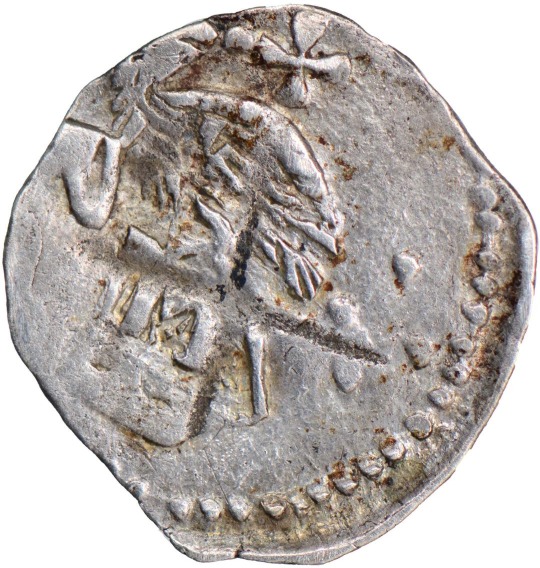


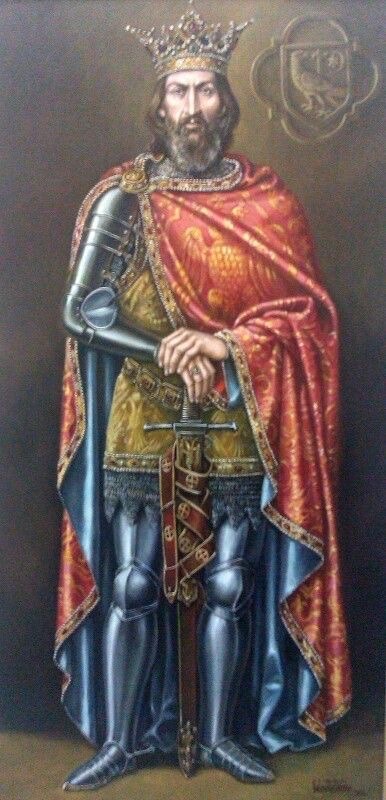
Mircea the Elder in Numismatics and Medalistics
“Mircea the Elder (1386 – 1418) was the son of Radu I and ruler of Wallachia. He was also known in history as Mircea the Great and succeeded to secure for the province of Wallachia its largest territorial span, as well as its highest geopolitical status ever.
1402 would bring important changes in relations with the Ottoman Empire. The defeat and capture of Bayezid I by the Mongols under Tamerlane opened a path for power struggles and political infighting within the Ottoman Empire. The confrontation between the sons of Bayezid I was carefully speculated upon by Voivode Mircea, who at first supported Musa against Emir Süleyman, with an aim towards weakening Ottoman power. Musa was initially defeated and took refuge in Wallachia, yet with the help of Mircea he succeeded in occupying Adrianople, the capital of the Ottoman State at the time, and became Sultan. It was during this period that Wallachia reached its greatest territorial breadth, as documented by a chronicle of 1406 in which the voivode claims that “by virtue of Christ the Lord, as a good believer and a good worshipper, lover of Christ and autocrat, Io[an] Mircea, great voivode and ruler at the mercy of God and by the gift of God, warding and ruling over the entire country of Hungary-Wallachia and over lands beyond the mountains, as well as over the Tatar lands, over Amlaş and Hertzeg Făgăraş, ruler over Banat Severin and both parts of Podunavia, up to the Great Sea and warden of the city of Darstor, do {…}”.
After 1397 (or 1402, according to some) Mircea initiated a monetary reform, whereby the gross weight and silver content of the ducats were increased. New elements in terms of iconography were introduced, consisting in representations of the voivode and of Jesus Christ, testifying to the important role of Mircea on the Balkan political scene, as well as to his capacity as defender of Christendom.
The first series of ducats depict a crowned Mircea the Elder standing and holding a vertical or inclined spear in his right hand, and the cross-bearing orb in his left hand. On the reverse there is an inclined shield with a helmet and the eagle of Wallachia on top. The second series of silver ducats in circulation after the reform of the monetary system feature a benediction by Jesus Christ on one side and on the other, Mircea holding a spear in his right hand and the cross-bearing globe in the left.
Mircea is depicted on some of the ducats wearing a Byzantine costume, while on others he is shown as a western knight. The currency of Wallachia did not only fulfil an economic function, but it was also a means of propaganda, with the voivode shown as per written documents “a sovereign voivode and sole ruler”. After the reform, the “ban” was reintroduced, a subdivision with an aim to ensure the needed amount of change money (coins). This currency was non-epigraphic and depicted a cross with arms of equal length on the obverse, and an inclined shield with the Wallachian eagle on top, on the reverse.
The second part of the reign of Mircea the Elder saw the minting of a series of coins that have given rise to a number of controversies among specialists, with some attributing them to the mint of the city of Severin. On the obverse they presented the effigy of the voivode and his name in Slavonic, and on the reverse a shield with the Wallachian eagle and an inscription in Latin, featuring the name of Petru or Petrusian. The mysterious character is not mentioned in chronicles as an associate to the throne, and there has been an ongoing debate about his origins, as well as with regard to the actual location where these coins were minted.”
Source: https://www.bnr.ro/Mircea-the-Elder-in-Numismatics-and-Medalistics
#romania#christian orthodox#christianity#byzantine#ottoman empire#wallachia#jesus christ#churches of romania#numismatics#silver coins#cross#europe#eastern europe#defending europe#history#photography#aestetic#monetary reform
190 notes
·
View notes
Text
Dracula (novel) cast & queerness my personal reading...
Prompted by an open question posed by @re-dracula. It’s public domain, interpret however you want these are just mine. By extension my portrayals. Contains spoilers for all of Dracula.

Mina: bi, genderqueer, formerly romantic with Lucy Westenra, now with Jonathan. brown/south asian.
Jonathan: bi, genderqueer, down bad for Mina. Also brown/south asian.
Quincey Harker: south asian through both parents, and adopted nephew of ethnic jew Van Helsing. Bi (female lean) and a wife man taking after his father the gentleman lawyer Jonathan Harker. Also vampire hunter of all time!

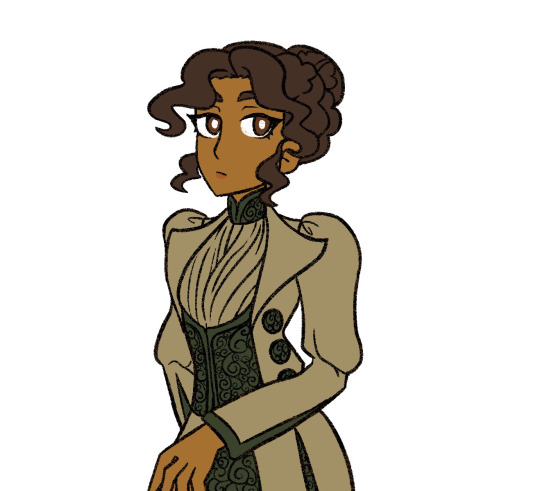
Art by a friend of mine!
Lucy: pansexual (sapphic leaning) polyam, with Mina and Arthur & Quincey. I would love to see a black Lucy someday and a good one following the ingenue in the novel!
Seward: Pansexual (closeted).
Van Helsing: elder gay and ethnically Jewish.
Arthur: bi (female lean). Dandy, rich, blonde and pretty.
Quincey Morris: bi (no lean). Mixed Latino and black.
Renfield: gay and codependent on Dracula.
Dracula: Pansexual (male lean). Wallachian.
The brides/roommates: bi (sapphic leaning). Also Eastern European and Dracula’s past victims ala @saintmachina’s Dowry of Blood. 👀: see here.

Tagging: @count-v-dracula, @wcstenra, @the-brat-prince-1760, @zoophagist, @grimgrinningghosts456, @0nelittlebirdtoldme, @carpathianprince , @monstershearts , @see-arcane, @marghen, @re-dracula, @covenofthearticulate @elisaintime, @victoriantheorist14 & @monstersinthecosmos - happy pride! 🏳️🌈🏳️⚧️ 🦇
undefined
youtube
undefined
youtube
undefined
youtube
undefined
youtube
undefined
youtube
#re: dracula#ooc / full of good men#about / mina#mina murray#mina harker#jonathan harker#quincey harker#quincey morris#lucy westenra#jack seward#dracula daily#dracula daily spoilers#brides of dracula#the weird sisters#dracula (1897)#Dracula (novel)#count dracula#Dracula headcanons#headcanon#headcanons#queer#lgbtq+#Bisexual#pansexual#gay#a dowry of blood#st gibson#long post#gothic horror#meta
18 notes
·
View notes
Photo
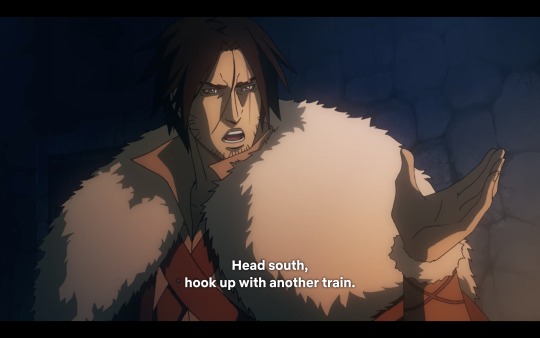
This line is probably just a random direction the writers chose, but geographically speaking, it was the Ottoman Empire that lay south of Wallachia. At the time Castlevania takes place, the Ottomans (chiefly Islam) were very open and tolerant of other religions compared to their European neighbors and granted asylum to cultural minorities. So not only is Trevor’s suggestion of heading south a means of escaping Dracula’s Horde, it’s also a means for Sypha’s people to escape religious persecution.

Sypha’s grandfather refers to their people as the Codrii Speakers. The Romanian word codru means ‘forest’ and codrii means ‘woods.’ So Sypha’s people are woodland Speakers.

By the time Vlad III Dracula ascended the throne for the second time in August 1456, a comet had been sighted over Wallachia. Based on the description by observing astronomers at the time and the calculations of moving celestial bodies, it is believed this was Halley’s Comet. The historical Dracula interpreted the sighting as a good omen and later incorporated the famous comet in coins minted during his reign. (Google searches show me none of the historical Dracula’s coins survive today, if he minted any specific to his reign at all. My source for this one is a book published in 1989: Dracula, Prince of Many Faces by Florescu and McNally, pg. 83. So make of this one what you will.)

The capital of Wallachia moved around a few times. When the principality was first founded in 1310, it was located at Curtea de Argeș. During the majority of Vlad III Dracula’s lifetime, it was at Târgoviște. In the autumn of 1476, it is believed he moved the capital to Bucharest for economic and military purposes and it remains to be the capital of Romania today. (Plus, in the context of the series, Târgoviște was a ruined city by 1476, so no wonder the ruling government cleared out.)
#castlevania netflix#trevor belmont#wallachia#medieval wallachia#medieval romania#medieval history#could be misinformed#wallachian politics and the history lesson no one asked for#historical post#historical context#dracula#speakers#the ottoman empire#castlevania#targoviste romania#belmont
327 notes
·
View notes
Text
#unhallowedarts - "I spread it over centuries, and time is on my side" - Bram Stoker's Dracula
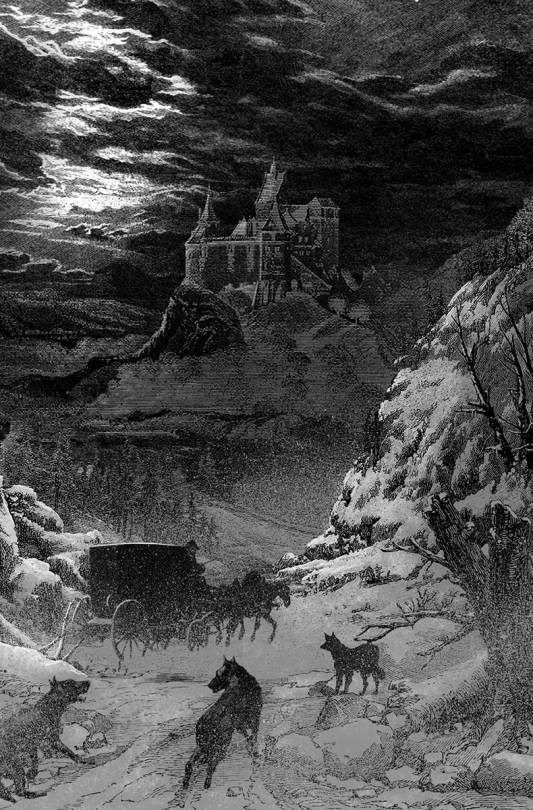
“You reason well, and your wit is bold, but you are too prejudiced. You do not let your eyes see nor your ears hear, and that which is outside your daily life is not of account to you. Do you not think that there are things which you cannot understand, and yet which are, that some people see things that others cannot? But there are things old and new which must not be contemplated by men's eyes, because they know, or think they know, some things which other men have told them. Ah, it is the fault of our science that it wants to explain all, and if it explain not, then it says there is nothing to explain. But yet we see around us every day the growth of new beliefs, which think themselves new, and which are yet but the old, which pretend to be young, like the fine ladies at the opera.“
(Bram Stoker “Dracula”)
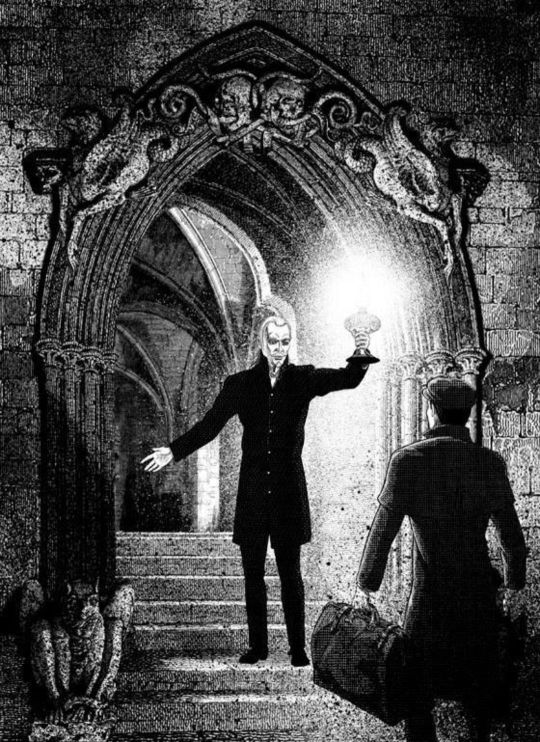
It was a indeed a dark and stormy night, the one in the year without Summer back in 1816, when the Shelleys, Byron and his physician John Polidori sat down to make pop culture history. Cut off from the world, bored witless and full to the brim with laudanum, his lordship challenged the gathered Romantic enfants perdu to lift the burden of ennui with telling ghost stories in the German fashion. And while both Byron and Shelley brought off rather nothing except consuming more narcotics that night, Mary famously began to write “Frankenstein” and Polidori engendered the other treasured dread, the aristocratic, suave, blood sucking king of the undead, the vampire. The myth itself was, of course, centuries old and only two generations before, a downright mass hysteria ran through Europe when repeated cases of vampirism were reported in the Balkans along the Austro-Turkish military border.
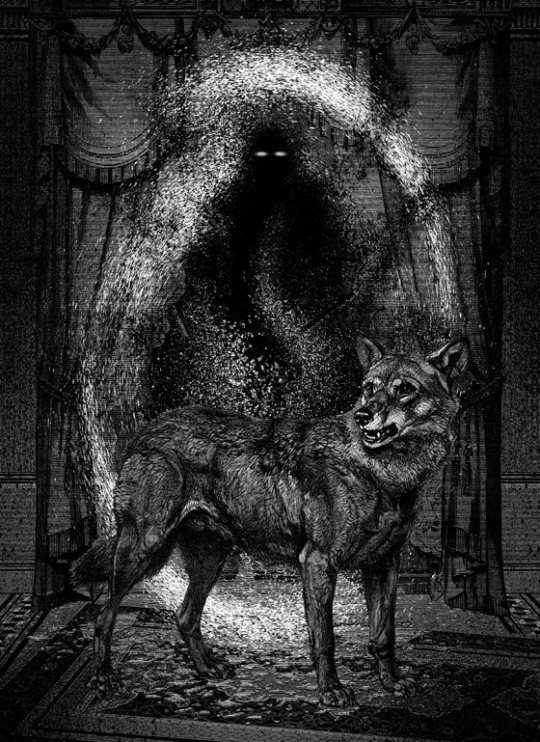
Polidori though took the revenant peasant prowling around his former home and sucking the blood of his family, clad him in evening attire and modelled him after the pattern of his employer into a Byronic hero. Polidori’s Lord Ruthven became the ancestor of the 19th and 20th century’s vampires that haunted the imaginations of countless readers and the pages of Gothic literature from the likes of Gogol and Merimee to the infamous penny dreadfuls. One of these featured a creature called “Varney the Vampire” who brought in the fangs and the tell-tale bite marks and Sheridan Le Fanu’s “Carmilla” from 1872 gave the myth the structure of a long dead noble á la Coleridge’s “Christabel” haunting a damsel in distress and a group of heroes bringing the creature to bay with the help of ancient lore and occult paraphernalia. The groundwork was laid and along came Bram Stoker.

As a child, Stoker was bedridden until the age of seven, rose as from the dead after his mysterious illness all of a sudden ceased, became a football star at college, graduated in mathematics and ended up a pen-pusher in Dublin Castle. Not satisfied with his lot, naturally, Stoker changed his career to theatre critic at the Dublin Evening Mail, owned by Sheridan Le Fanu, and attracted the attention of the famous actor Sir Henry Irving with a favourable review, the two became friends and Stoker followed Irving to become his manager. Meanwhile he had won the hand of Florence Balcombe, a celebrated beauty, courted by Stoker’s acquaintance form Trinity College Oscar Wilde as well as a host of other suitors. Stoker would bring these experiences into a literary form in his opus magnum “Dracula” with Sir Henry Irving acting as model for the undead count as Byron did for Polidori 80 years before.

Stoker had never been to Romania, during the 1890s a part of the Austro-Hungarian Empire, but he did a thorough research on his subjects that he would add with iconic effects to the imagery of the literary Gothic, from local legends of the 1750s, the late 15th century Wallachian Prince Vlad III. Drăculea who was famed in western European sources for his cruelty and other inspirations from Central Europe like Princess Eleonore von Schwarzenberg, rumoured to be a vampire during her lifetime at the beginning of the 18th century and already an inspiration for German poet Gottfried August Bürger to his poem “Leonore”. Well-known enough known to Stoker and everyone else who read and wrote Gothic literature.
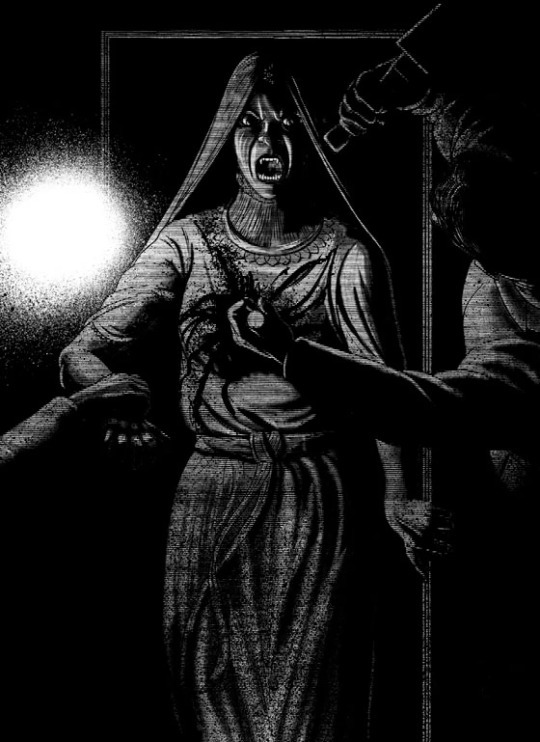
Pitting his research-wise well founded mythical Count and his ancient evil that bears strong resemblances to the feared syphilis as well as despicable moral liberties against the forces of the modern age, trains, the telegraph, typewriters, repeating rifles and established processes and organised teamwork, based on thorough research. Published in 1897, “Dracula” became an instant success and the standard followed to this day, even if Stoker and “Dracula” act only as powers behind the throne of “Urban Fantasy”.

All artwork above is by John Coulthart from his 2018 take on "Dracula" and nicked from his blog linked below
#unhallowedarts#dark art#dark literature#dark academia#gothicliterature#gothic art#victorian gothic#gothic aesthetic#bram stoker#bram stocker's dracula#dracula novel#vampire art
59 notes
·
View notes
Text
For Life Or Until Fault
Alt Timeline 2.0 - Darrell x Odile (Part 6)
Warnings: MINORS DNI! Main characters are slasher ocs. Implied murder. Mutual stalking involved.
Darrell belongs to me ♥︎
Odile belongs to @solmints-messyocdiary
Tagging my beloved @ajarofpickledtears who might get a kick out of this 🥹💕

Footsteps were muffled by the dusty, dull green carpet. Hardly anyone was at the library, and Darrell was sure that this might just be the norm. He waited for the kindly librarian to find the newspaper article he had asked for.
They huddled in front of a computer hooked up to a microfiche reader, sifting through page after page of old local newsprint. Finally, the librarian gave a satisfied "Ah!"
"Here we are," she told Darrell cheerfully, "I'll leave you to it, then."
She stepped aside to let Darrell slide into the chair in front of the monitor. "If you want to print anything," she said, "the computer's linked to the printer so just click this little picture here."
Darrell thanked her and began to read the article about the accident the town had simply dubbed as "The Fire". Not out of indifference, but of grim aversion. It was a ghastly thing, a tragic event that supposedly took the lives of a woman, a kindly priest, and his quaint charge.
Overturned candles, the authorities suspected, or some electrical problem. It could all have been easily avoided. Such a shame.
Perhaps by some printer's mishap, the photographs of Father Henrik and the woman were grainy. Parts of their faces were even blotted out completely.
Her, however. Her face was bright as day.
Odile, the description read, church custodian.
A timid beauty that drew the eyes to her spot on the page, where she presided like a saint over adverts and small town news.
From the corner of his eye, he noticed a slender figure lingering by the bookshelves. It was the ring leader from his last visit, swaying in place with her baby braids and her school skirt perched too high on her waist. Darrell kept his eyes on the screen.
An article - no bigger than his palm - ruefully declared that yet another body had been found gutted and impaled on a pike. No doubt the work of the killer the press had dubbed "Tepeş" - The Impaler - after the infamous Wallachian prince. Curiously, all his victims had been men who had a history of violence.
The governor was quoted to say, "I would not trade this horror for less congested jails. There is a perverse gratification in this for this individual."
That had been years ago. As far as Darrell knew, the killer had never been caught.
He hit a button and headed for the printer.
Her picture was warm in his hands, and he trembled as he folded away the parts that didn't matter.
At the book checkout, the little minx strolled up beside him, bearing a racy vampire novel in her hands. She ventured for small talk. Darrell tried to make it evident that he wasn't interested. She was however, persistent. "Who's she?" she asked, eyeing the picture.
Darrell covetously snuck Odile between the pages of the book he'd picked. She watched him draw his lips into a tight line. "She isn't your girlfriend is she?" She chuckled. "If she were, she'd give you her picture herself. You wouldn't need to print it from the library."
"You like him? He's quite a character."
Darrell glanced at his book's cover. Vlad the Impaler: His Life and Exploits, the title read.
"I think he's awful," Darrell told her. "But I'm feeling quite nosy today. Might want to get all up in his business. No school today?"
"Done for the day."
"What year are you in?"
"11."
"That makes you… what 16?"
"Yep." The young girl flashed him a pretty smile, revealing a row of perfect white teeth.
"I'm 31," Darrell said pointedly.
"I don't mind."
Darrell nodded once. "But your mother will. Maybe I'll have a talk with her."
The color drained from her face and her round eyes grew even wider. She suddenly looked like she wanted to get as far away from Darrell as she could.
"Look." He sighed. "You seem like a nice girl, ok? Don't waste your time on grunts like me. I promise I'm not at all that interesting."
He thanked the librarian for her help and made his quiet way to the door.
~
Darrell had seen no sign of the girl since their unfortunate first meeting. He'd left her little trinkets, apologies after he'd upset her, on a mossy footstone near the fringes of the forest.
So far she'd taken none of his gifts, but he did feel eyes on him when he came bearing new flowers - the last of that prematurely cold season. He pretended, then, not to notice as she pretended not to watch.
Sometimes, when Isabelle begged, Darrell would let her run to the forest to play with the girl. They seemed to be familiar with each other, and he caught himself smiling when he heard her giggle from somewhere in the woods. When he did spy her from a distance, he would venture a smile.
At last, she'd left carnations on the footstone for him, and he gladly took them home. The splash of color livened up the sickly yellow parlor.
One day, he woke up and took the 2-kilometer walk to the town. He purchased a pack of steaks from the lone supermarket. While leaving it out on the footstone, he hoped she had a stove. Hot food would certainly help with the cold weather.
He sat down beside his new offering, tired from the trip, and decided to rest before heading back to start the day's rounds. Somewhere between debating whether to start with the western or the eastern half of the cemetery, he fell into a doze.
The rustle of plastic wrap woke him with a start. He let out a soft gasp and froze.
There she was; Her posture tense. Her eyes blown wide; Grasping a blood-red steak in one hand, a ribbon of flesh making a bridge between her lips and her knuckle.
She began to scuttle away on her knees, and Darrell begged her to wait. "Please." He raised his hands as if to say I mean you no harm.
"I'm sorry," he said, his heart beating like a drum. Her brow crumpled in confusion. "About last time."
The recollection of their first meeting obviously made her embarrassed, and her eyes immediately became misty.
"Are you hungry?... C-cold? I… I can - want - to help, if you let me."
She dropped the steak and gingerly ran her palms over her arms, hugging herself. She looked into his face, trying to read his expression for any danger, any ruse.
"It's alright, Odile."
She gasped under her breath, and her eyes shifted into focus - her attention falling full on the man in front of her. The world seemed to grow sharper around the edges and she could see. The verdant hills beyond, the blue-gray heavens above, and the freckles on his face. It was all so clear.
"W-what?" she asked, her voice hardly rising over a whisper, as if she'd been roused from a deep slumber.
"Odile," he repeated, "I-is that your name? Odile?"
She felt a tug at her heartstrings and at the corners of her lips. Yes! Of course, how could she have forgotten? She had a name!
"Y-yes." She nodded. "My name… my name is Odile."
The smile he gave her was relieved, radiant. "That's a lovely name."
She quickly brushed the back of her hand over her cheeks, hoping he didn't catch the tears that had fallen.
"Well, hello, Odile. I'm Darrell," he said, "I'm happy we've properly met.”
"Here." He took off his jacket and draped it around her bare shoulders. She tucked herself into it, delighting in his warmth that was still enmeshed in the fabric.
He asked a question and she started, blinking blearily. "Hmm?"
“Shall we head for the manor? Get out of the cold?"
She nodded, and began to slowly reach for his outstretched hand. She jerked back. Tears suddenly welling from her eyes.
She stumbled back, fingers clinging still to the lapels of Darrell's jacket. She wasn't ready to let go just yet, but she told him what had plagued her since that day in the forest, "I-I've been horrible." Her next words were caught between a sob. "I didn't… I didn't mean to! I-I'm sorry!
"Oh, no, princess." Darrell flew to her side, brushing her arms to soothe her. "No, no, no, no, no. Please don't cry. It's alright."
"I-It's just that I was hungry and there was nothing left. I wouldn't have if I could, but-"
"I know," Darrell assured her. He pulled her to his chest, hastily wiping her tears away with his thumb.
"I'm sorry I did it. Oh, please," Odile wailed. "Don't hurt me."
Darrell took her face in his hands, wishing he could find the right thing to say to make her grief go away. "Nothing bad is going to happen to you," he told her. "I won't allow it. Okay? You poor girl. Shhh…"
"But they brought you here t-to find me… to make me pay.. f-for all my sins…"
Darrell stared into those olive green eyes, the pupils wide enough to look like chasms. Her nails dug crescents in his forearms, threatening to draw blood as she struggled to keep her breath even. He shook his head. "I swear, nothing will ever happen to you. I won't hurt you, and I won't give you to them."
"Please." Darrell could have winced at the way his voice cracked. "Come with me."
Odile was exhausted, and she was scared. But he offered warmth and kindness. Besides, Odile knew in her frail little heart, that there was no other place she wanted to be than with him.
#for life or until fault#odile x darrell#alt timeline 2.0#darrell todd#oc: odile#odile#odile and darrell my beloved#bluecoolr.txt#gotta go update the masterlist again
12 notes
·
View notes
Text

Ships that stopped at Whitby Harbor (Seen here circa 1880) inspired Bram Stoker as he wrote Dracula. Photograph By Frank Meadow Sutcliffe, The Royal Photographic Society Collection/Victoria and Albert Museum, London/Getty Images
The Little-Known Shipwreck That Inspired Bram Stoker’s ‘Dracula’
Stoker was moved by grim details from the world around him while penning his horror masterpiece. The real fate of a ship called the Dmitry played an outsized role in his imaginings.
— By Melissa Sartore | August 18, 2023
The arrival of the Demeter in Bram Stoker's Dracula serves as a fundamental part of the titular character's story: the ship brings death himself to England.
Stoker drew inspiration for his genre-defining horror novel from his time in Whitby, and the dark 1885 fate of the real ship Dmitry on the town’s shore.
The death and tragedy around Stoker ultimately shaped the story that became one of the most famous pieces of English literature and set the stage for the next century of vampire lore.

The wreck of the Dmitry from Narva, now Estonia, aground on Tate Hill Beach in 1885, Whitby, Yorkshire, UK. Photograph By Frank Meadow Sutcliffe, Colin Waters/Alamy Stock Photo
The Dmitry Becomes the Demeter
During the summer of 1890, Irish novelist Bram Stoker vacationed at the seaside town of Whitby in northeast England. Despite spending only a month in the town, Stoker was enthralled by his surroundings: Grand Mansions and Hotels lined the West Cliff while remains of the seventh century Whitby Abbey towered over the East Cliff. Nearby, the cemetery at the Parish Church also served as inspiration as the story of Dracula came to life.
Stoker was also enchanted by the many ships making harbor here. He reportedly visited the Whitby Museum to explore the history of these vessels, as well as a local library, where he came upon William Wilkinson’s book The Accounts of Principalities of Wallachia and Moldova. Stoker marked in his notes:
DRACULA in the Wallachian language means DEVIL. The Wallachians were, at that time, as they are at present, used to give this as a surname to any person who rendered himself conspicuous either by courage, cruel actions, or cunning.
Stoker reportedly asked around the shore about shipwrecks in Whitby, notably the Dmitry, a ship that had wrecked five years earlier.
The cargo vessel Dmitry had set sail from Narva in Russia (modern-day Estonia) in 1885. On October 24, the Dmitry was one of two ships run ashore at Whitby by “a storm of great violence,” according to contemporary newspaper accounts. The other vessel, the Mary and Agnes, was stranded in the raging sea and a lifeboat was sent to rescue its crew. When the crew of the Mary and Agnes was ferried to the shore, per the Leeds Mercury, “their safe landing [was] the signal for loud huzzas by the thousands of people assembled on shore.”
Those same onlookers watched on to see what would happen with the Dmitry. As reported by the North-Eastern Daily Gazette, the crew remained on board in the hopes they would be able to dock, but “the sea beat savagely against the vessel. Her masts gave way and fell with a crash over her side, and the vessel herself began to break up.”
Though unclear exactly how they were rescued, in the end, all seven members of the Dmitry’s crew were safely brought to shore.
There were several unique aspects to the last voyage of the Dmitry that appear to have stood out to Stoker. The Demeter originated in Varna (an anagram for Narva, where the Dmitry originated), and similarly carried “ballast of silver sand, with only a small amount of cargo—a number of great wooden boxes filled with mould.”
Through conversations with fishermen in Whitby, Stoker learned of an untold number of local deaths at sea. Stoker reportedly made note of some 90 names from gravestones in Whitby for future use in his story, including the surname “Swales.” Soon after the arrival of the Demeter in Dracula, he wrote “Mr. Swales was found dead… his neck being broken.”
What Inspired Dracula’s Canine Form?
In Stoker’s novel, Dracula himself took the form of a dog to make his way from the Demeter to dry land, but there was no dog reported to have been on the Dmitry. According to Mel Ni Mhaolanfaidh and Marlon McGarry in 2021, the dog in Dracula may be an homage to the wreck of the Greyhound in 1770.
The Greyhound sailed from Whitby and sank off the coast of Ireland on December 12, 1770 (120 years prior to Stoker’s arrival in the town). Stoker’s mother, Charlotte, was from Sligo, a town in close proximity to the wreck. When the storm that sank the ship surged again, a young cabin boy was left stranded. The rescue effort failed, with only one out of the some 20 men sent to save him tragically dying in the process.
Stoker made no reference to a dog in his notes until two months after he’d departed from Whitby. On October 15, 1890, Stoker wrote, “When ship ran in to Collier's Hope, big dog jumped off bow & ran over pier - up Kiln Yard & church steps & into churchyard…Local dog found ripped open & graves torn up…” It’s not clear if Stoker learned of these details from the Dmitry wreck, another Whitby wreck, or was his own creation.
In the novel, the arrival of the Demeter was paired with a similarly remarkable incident: “The very instant the shore was touched, an immense dog sprang up on deck from below, as if shot up by the concussion, and running forward, jumped from the bow on the sand.”
The dog, a disguised Dracula, wrought bloodshed and death from that point forward. This dog resembled the barghest, a mythical monster often associated with Yorkshire. Spellings and specific forms of barghest vary but the dog-like being foretold of pain, disaster, or even death to all who saw it. The barghest also elicited howling from dogs in its vicinity, something Dracula protagonist Mina Murray reported took place soon after the arrival of the Demeter.
#Dracula#Whitby Harbor | Yorkshire | UK 🇬🇧#Frank Meadow Sutcliffe#Bram Stoker#Shipwreck#Horror Masterpiece#Northeast England 🏴#Grand Mansions | Hotels | West Cliff#Cemetery | Parish Church#Whitby Museum#William Wilkinson#The Accounts of Principalities of Wallachia and Moldova 🇲🇩#Cargo Vessel Dmitry#Narva in Russia 🇷🇺 | Modern-Day Estonia 🇪🇪#The Mary & Agnes#North-Eastern Daily Gazette#Mr. Swales#Mel Ni Mhaolanfaidh | Marlon McGarry#Greyhound#Charlotte | Sligo#Collier's Hope#Mina Murray | Dracula Protagonist
15 notes
·
View notes
Text
So, I heard Castlevania Nocturne season 2 is in the works. Big excite! That being said!
I'm overall fine with Nocturne as is if only because I know that Castlevania is no stranger to negative fan feedback whether it's legitimate grievances or petty complaints (and Nocturne is flawed, I won't argue that) – just look at the series history. Simon's Quest being a different sequel like Adventure of Link, 64 being called the worst Castlevania game for years (go watch Ragnarrox's video on it), Dawn of Sorrow and Portrait of Ruin having an anime art style despite Rondo being just as anime if not more so, Symphony being too easy, Ecclesia being too hard, the very existence of Judgment and its take on the characters, Shadowvania being fine or a God of War ripoff. There will ALWAYS be Castlevania fans who dislike something, whether it's retconning Sonya Belmont or Netflixvania simply existing.
I've also played very few games in the entire series (GBA trilogy, SotN, Order of Ecclesia, Lords of Shadow: Mirror of Fate, bit of Dracula X) so the changes in Nocturne don't bother me that much if at all, and my general sense of being fine with Nocturne set in the French Revolution boils down to "Rondo was set during that period and France is one of the stages in Bloodlines". It also helps that I don't have as much energy for vitriol in my old by tumblr standards age, and I know adaptations will change things for better or worse... and Nocturne could have been worse. Imagine if Uwe Boll directed Nocturne.
So far Season 1 presents a fast and loose adaptation of Rondo of Blood with elements from Bloodlines and a dash of Aria of Sorrow (the eclipse) and a smidge of Harmony of Dissonance, just as the previous series adapted Dracula's Curse with bits from Curse of Darkness (Hector and Isaac) and Symphony of the Night (character designs and Lisa's death). Nocturne needs to adapt Rondo in order to properly introduce Richter and Maria and set things up for Symphony, obviously. Assuming it goes that far in future seasons, which it might.
But depending on how things go, once Nocturne is finished with Rondo and if it moves on to Symphony, there's a key element of SotN's story that falls apart when you remember that Dracula and Lisa were resurrected at the end of Castlevania Season 4; SotN happens because Richter is possessed and brings back both the Castle and Dracula, but you can't resurrect someone who's still alive, assuming Dracula hasn't died in the interim between Season 4 and Nocturne, and a whole village was being built around the still standing Castle last time we saw it. So what happens then?
An important thing to note is that Lament of Innocence, chronologically the first game in the timeline, happened in Netflixvania; Trevor mentions Leon Belmont, the game's protagonist. Lament is also where we see Dracula's origins not as a Wallachian prince turned vampire, but as Leon's friend Mathias Cronqvist – a fellow crusader who after the death of his wife Elizabetha, became Dracula by taking the soul of the vampire Walter Bernhard into a vampiric treasure called the Crimson Stone, which is basically if a Philosopher's Stone gave you vampirism because that's a kind of immortality. (There's also the Ebony Stone which is a vampire treasure like the Crimson Stone, the colors are important because there's some alchemy in Lament.)
In SotN Alucard describes the Castle as "a creature of chaos. It may take many incarnations." Apparently in the game Dracula's Curse, Dracula made a pact with the Evil God – who may or may not be Satan, somebody at Konami please clarify – to gain the power of Chaos (and also a monster horde), which would neatly explain why Netflix Drac needed a year to prep his assault after Lisa was burned at the stake. In Aria of Sorrow (in which Dracula dies for good in 1999 and is reincarnated as Soma Cruz), the final boss is literally Chaos, and its second form takes the appearance of (among other things) a black stone that flashes red – Castlevania is a creature of Chaos and the center of it is the Crimson Stone, the origin of Dracula's power.
In Dawn of Sorrow, the cult under Celia Fortner created a "perfect replica" of the Castle and wants to make a whole new Dracula; it isn't outright stated iirc, been a while since I played it, but I'm guessing the implication is that Celia created another Crimson Stone to be a new Chaos for the Castle. Plus, with two candidates being groomed for the Dark Lord position (and Soma himself being Dracula reborn and getting involved), someone would have to be sacrificed like Walter was so someone can become Dracula 2.0.
However, I don't recall seeing a Crimson Stone in Netflixvania, which is interesting considering the focus on alchemy once Saint Germain gets involved. Considering how spotty Trevor's knowledge of the Belmont family's history is, he probably didn't know how Dracula became Dracula. Maybe Leon took that knowledge to the grave, or maybe Sypha uncovered the identity of the man who became Dracula years later while she and Trevor raised their child Simon. If Nocturne will one day adapt Symphony, it needs to address the lack of a Dracula to resurrect. Maybe it can take a leaf out of Dawn of Sorrow's book and have a cult just try to make a new Dracula to replace the old one, and the party meets up with the Vlad Tepes Formerly Known as Dracula in order for him to explain how he became what he is and what the cult is doing, not to mention the whole possessed Richter part... or, perhaps the cult mind controls Richter into going through the motions so he can be forced to sacrifice someone, perhaps one of vampiric blood like Alucard, to take on the Dark Lord's mantle. It certainly wouldn't be the first time a Belmont became a Dracula!
10 notes
·
View notes
Text
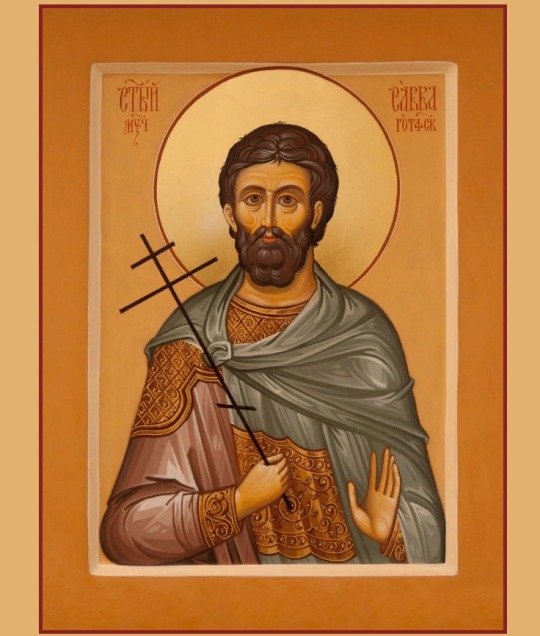
+++🙏🏻God Bless🕊️+++
Martyr Savva of Gotfa, Mussov (Wallachian)
MEMORIAL DAY APRILL 28
💫International Orthodox Art Corporation Andcross
May the blessing of the Lord be upon you!
#orthodox church#orthodox icon#orthodoxia#orthodox christmas#russian orthodox#jesus#orthodox christian#greek orthodox#orthodox#iconofaday
4 notes
·
View notes